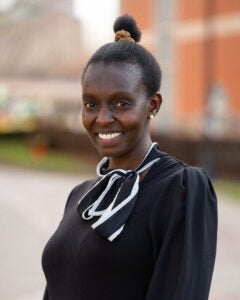 Dr. Habiba Chirchir earned a B.A. in Anthropology from the University of Nairobi in 2005, an M.A. in Anthropology (skeletal biology track) from New York University in 2008, and a Ph.D. in Human Paleobiology from George Washington University in 2013. She completed her postdoctoral research in 2015 at the National Museum of Natural History, Smithsonian Institution. In addition to being an associate professor in the biology department at Marshall University, she is a research associate at the Smithsonian Institution. She is a biological anthropologist and anatomist. Her research is on understanding how behavior and evolutionary processes influence bone morphology with a focus on the human fossil record. Her work set out to understand why humans have lower bone density than our ancestors and other primates and hypothesized that this difference showed up a couple of million years ago, around the time of Homo erectus, a species whose features we seem to have retained. But, after examining early human fossils using CT imaging, it was surprising to find it all started when humans shifted from foraging and hunting, to growing food and raising livestock – a recent phenomenon in human pre-history. One of the explanations for these light skeletons is that it was a response to reduced physical activity. However, she also uses living mammalian analogs including primates, canids and, felids to test alternative explanations, whether the light skeletons are a byproduct of evolutionary selection in modern humans. This work has implications for understanding modern day bone disease as we have an overall increased risk to bone diseases such as osteoporosis potentially precipitated by our unremarkable skeletons. Students are a key part of her research, and she has thus mentored a number of undergraduate and graduates in biology and biological anthropology departments. In addition to her research, she is also an educator. She primarily teaches courses in human anatomy, human biology, evolution, among others. Habiba is a STEM advocate, by melding her research findings and teaching skills, she has directed her efforts to developing course materials to be used by high school biology teachers to teach evolution as part of their courses in her home country of Kenya. She has also been engaged in training high school anatomy teachers in WV and their students, with particular emphasis on underrepresented students in STEM, to better prepare them for anatomical education in college in West Virginia. She was named a Distinguished Drinko Fellow in 2022.
Dr. Habiba Chirchir earned a B.A. in Anthropology from the University of Nairobi in 2005, an M.A. in Anthropology (skeletal biology track) from New York University in 2008, and a Ph.D. in Human Paleobiology from George Washington University in 2013. She completed her postdoctoral research in 2015 at the National Museum of Natural History, Smithsonian Institution. In addition to being an associate professor in the biology department at Marshall University, she is a research associate at the Smithsonian Institution. She is a biological anthropologist and anatomist. Her research is on understanding how behavior and evolutionary processes influence bone morphology with a focus on the human fossil record. Her work set out to understand why humans have lower bone density than our ancestors and other primates and hypothesized that this difference showed up a couple of million years ago, around the time of Homo erectus, a species whose features we seem to have retained. But, after examining early human fossils using CT imaging, it was surprising to find it all started when humans shifted from foraging and hunting, to growing food and raising livestock – a recent phenomenon in human pre-history. One of the explanations for these light skeletons is that it was a response to reduced physical activity. However, she also uses living mammalian analogs including primates, canids and, felids to test alternative explanations, whether the light skeletons are a byproduct of evolutionary selection in modern humans. This work has implications for understanding modern day bone disease as we have an overall increased risk to bone diseases such as osteoporosis potentially precipitated by our unremarkable skeletons. Students are a key part of her research, and she has thus mentored a number of undergraduate and graduates in biology and biological anthropology departments. In addition to her research, she is also an educator. She primarily teaches courses in human anatomy, human biology, evolution, among others. Habiba is a STEM advocate, by melding her research findings and teaching skills, she has directed her efforts to developing course materials to be used by high school biology teachers to teach evolution as part of their courses in her home country of Kenya. She has also been engaged in training high school anatomy teachers in WV and their students, with particular emphasis on underrepresented students in STEM, to better prepare them for anatomical education in college in West Virginia. She was named a Distinguished Drinko Fellow in 2022.
Press Release
2022 Drinko Symposium photo gallery
2022 Drinko Symposium video